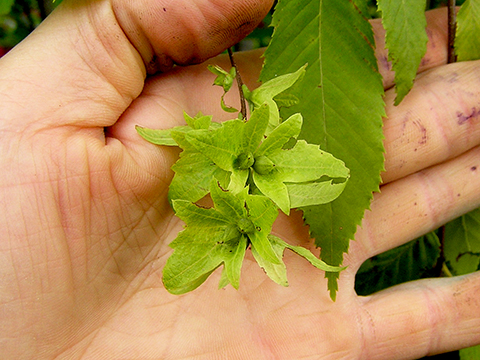 |
| Home | Ordering By Mail | Purchase Manual: Using Native Plants in Urban Landscapes |
|
|||||
Species Name: Carpinus caroliniana
Common Name: American hornbeam, ironwood, Blue beech, Musclewood
Zone: 3 to 8
Distribution: Nova Scotia south to Florida, west to Minnesota in the north and Texas in the south.
Seed collection: Begin collecting seed in early September. Seed is a small hard nutlet enclosed by a three lobed bract which functions as a sail for dispersal. The seeds hang in tight clusters at the ends of young twigs. The seed and the bracts change color from green to yellowish green to light brown when fully ripe. Early harvest of seed before complete color change can increase germination percentages the first spring. Seed often develops a deep dormancy if allowed to remain on the tree. Strip seed clusters from the branches or shake seed from the tree onto a sheet. Most trees produce a prodigious quantity of seed every year so it is easy to collect lots of seed.
Seed handling: Remove bracts from the seeds by rubbing over a screen to reduce bulk and make it easier to handle the seed. The seed can also be placed in a food processor for dewinging. The embryo is enclosed by a hard pericarp. Begin cold/moist stratification soon after seed collected or cleaned.
Germination requirements: American hornbeam germination is very unpredictable. It is rare to get uniform germination. Seed that is cold/moist stratified over the winter will be ready to germinate the first spring. A one to 2 month period of warm/moist stratification followed by cold/moist may increase germination rates. From 1/3rd to ½ of the seed may be expected to germinate the first year. The majority of seed will require at least two years to germinate, but seed will often germinate up to three or more years after collecting. Stratified seed can be kept in plastic bags until it germinates, pick out individual seeds as they germinate or sow all seed in prepared seed beds or flats. Young germinating seedlings can be gently removed from the flats and planted in individual pots.
Ecology: American hornbeam is a small to medium sized tree reaching heights of 30 ft. It often grows as a multi-stemmed tree and has a tendency to root sprout forming small clonal groupings. It also develops numerous side branches rarely having a straight stem. Rate of growth is slow to medium when young, and slow with age, the tree never reaches a tall or large diameter.
Its wood is very hard, heavy and durable. It never reaches commercial timber size but it makes an excellent firewood. Its hard wood use to be used for implement handles.
Hornbeam will grow in a range of soils and moisture types but will tolerate moist poorly drained heavy soils better than other species. Hornbeam often grows as an understory tree when over topped by large species. Its nutlets are consumed by small mammals and many songbirds.
Hornbeam makes an excellent landscape tree as it has good form lovely foliage and exquisite fall color. Hornbeam should be encouraged anywhere there is a need for a small native tree. In the understory of open woodlands, along streams, damp woods, forest margins and hedgerows.

American hornbeam seed ready for collection. Seed with 3 lobed bracts attached.
this page posted January 6th, 2014